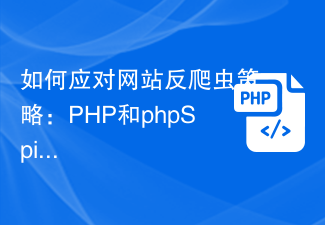 Backend Development
Backend Development PHP Tutorial
PHP Tutorial PHP-based crawler implementation: how to combat anti-crawler strategies
PHP-based crawler implementation: how to combat anti-crawler strategiesWith the continuous development and popularization of the Internet, the demand for crawling website data is gradually increasing. In order to meet this demand, crawler technology came into being. As a popular development language, PHP is also widely used in crawler development. However, some websites adopt anti-crawler strategies in order to protect their data and resources from being easily crawled. So, how to combat these anti-crawler strategies in PHP crawler development? Let’s find out below.
1. Pre-requisite skills
If you want to develop an efficient crawler program, you need to have the following skills:
- Basic HTML knowledge: including HTML structure , elements, tags, etc.
- Familiar with the HTTP protocol: including request methods, status codes, message headers, response messages, etc.
- Data analysis capabilities: Analyze the HTML structure, CSS styles, JavaScript code, etc. of the target website.
- Certain programming experience: Familiar with the use of PHP and Python programming languages.
If you lack these basic skills, it is recommended to do basic learning first.
2. Crawl strategy
Before you start writing a crawler program, you need to understand the mechanism and anti-crawler strategy of the target website.
- robots.txt Rules
robots.txt is a standard used by site administrators to tell crawlers which pages can and cannot be accessed. Please note that compliance with robots.txt rules is the first requirement for a crawler to be a legal crawler. If a robots.txt file is obtained, please check it first and crawl it according to its rules.
- Request frequency
Many websites will limit access frequency to prevent crawlers from accessing too frequently. If you encounter this situation, you may consider adopting the following strategy:
- Request again after taking a break. You can use the sleep() function to wait for a period of time before making the request again.
- Parallel requests. You can use multiple processes or threads to send requests to improve efficiency.
- Simulate browser behavior. Simulating browser behavior is a good approach because it is difficult for the server hosting the website to tell whether your program is accessing the web page as a human.
- Request header
Many websites use the request header information to determine whether to accept requests from crawlers. It is important to include the User-Agent information in the request header because this is important information sent by the browser. In addition, in order to better simulate user behavior, you may also need to add some other information to the request header, such as Referer, Cookie, etc.
- Verification Code
Today, in order to deal with crawlers, many websites will add verification codes when users interact to distinguish machines from humans. If you encounter a website that requires you to enter a verification code to get data, you can choose the following solution:
- Automatically recognize the verification code, but this is not a feasible solution unless you have some excellent Third-party verification code solving tool.
- Manual solution. After reading the analysis page, you can manually enter the verification code and continue running your crawler. Although this solution is more cumbersome, it is feasible in harsh situations.
3. Code Implementation
When developing PHP crawlers, you need to use the following technologies:
- Use cURL extension library
cURL is a powerful extension that enables your PHP scripts to interact with URLs. Using the cURL library, you can:
- Send GET and POST requests
- Customize HTTP request headers
- Send Cookies
- Use SSL and HTTP Authentication
It is one of the necessary technologies for executing crawlers. You can use cURL like this:
// 创建 cURL 句柄 $curl = curl_init(); // 设置 URL 和其他属性 curl_setopt($curl, CURLOPT_URL, "http://www.example.com/"); curl_setopt($curl, CURLOPT_RETURNTRANSFER, true); curl_setopt($curl, CURLOPT_HEADER, false); // 发送请求并获取响应 $response = curl_exec($curl); // 关闭 cURL 句柄 curl_close($curl);
- Using regular expressions
When crawling specific content, you may need to extract data from the HTML page. PHP has built-in support for regular expressions, and you can use regular expressions to achieve this functionality.
Suppose we need to extract the text in all title tags <h1></h1> from an HTML page. You can achieve this by:
$html = "....."; $pattern = '/<h1 id="">(.*?)</h1>/s'; // 匹配所有 h1 标签里的内容 preg_match_all($pattern, $html, $matches);
- Using PHP Simple HTML DOM Parser
PHP Simple HTML DOM Parser is a simple and easy-to-use PHP library that uses something like jQuery Selector syntax to select elements in an HTML document. You can use it to:
- Parse HTML pages and get elements
- Simulate clicks and submit forms
- Search for elements
Installation PHP Simple HTML DOM Parser is very simple and you can install it through Composer.
- Use a proxy
Using a proxy is a very effective anti-anti-crawler strategy. You can spread your traffic across multiple IP addresses to avoid being rejected by the server or generating excessive traffic. Therefore, using a proxy allows you to perform your crawling tasks more safely.
Finally, no matter which strategy you adopt, you need to comply with relevant regulations, protocols and specifications in crawler development. It is important not to use crawlers to violate website confidentiality or obtain trade secrets. If you wish to use a crawler to collect data, make sure that the information you obtain is legal.
The above is the detailed content of PHP-based crawler implementation: how to combat anti-crawler strategies. For more information, please follow other related articles on the PHP Chinese website!
 如何使用 PHP 爬虫爬取大数据Jun 14, 2023 pm 12:52 PM
如何使用 PHP 爬虫爬取大数据Jun 14, 2023 pm 12:52 PM随着数据时代的到来,数据量以及数据类型的多样化,越来越多的企业和个人需要获取并处理海量数据。这时,爬虫技术就成为了一个非常有效的方法。本文将介绍如何使用PHP爬虫来爬取大数据。一、爬虫介绍爬虫是一种自动获取互联网信息的技术。其原理是通过编写程序在网络上自动获取并解析网站内容,并将所需的数据抓取出来进行处理或储存。在爬虫程序的演化过程中,已经出现了许多成熟
 UniApp实现实时定位与位置分享的实现技巧Jul 04, 2023 am 09:22 AM
UniApp实现实时定位与位置分享的实现技巧Jul 04, 2023 am 09:22 AMUniApp实现实时定位与位置分享的实现技巧引言:在现代社会中,实时定位和位置分享已成为移动应用程序中的常见功能之一。而在UniApp开发中,如何实现这些功能是程序员们关注的焦点之一。本文将介绍UniApp中实现实时定位和位置分享的技巧,并附带代码示例,帮助读者更好地理解和应用这些技术。一、实时定位的实现要实现实时定位功能,我们可以利用DCloud平台提供的
 Vue 中实现走马灯及轮播图的技巧及最佳实践Jun 25, 2023 pm 12:17 PM
Vue 中实现走马灯及轮播图的技巧及最佳实践Jun 25, 2023 pm 12:17 PM随着Web应用程序的普及,轮播图和走马灯成为前端页面中不可或缺的组件。Vue是一个流行的JavaScript框架,它提供了许多开箱即用的组件,包括实现轮播图和走马灯。本文将介绍Vue中实现走马灯和轮播图的技巧和最佳实践。我们将讨论如何使用Vue.js中的内置组件,如何编写自定义组件,以及如何结合动画和CSS,让您的走马灯和轮播图更具吸引力
 高性能PHP爬虫的实现方法Jun 13, 2023 pm 03:22 PM
高性能PHP爬虫的实现方法Jun 13, 2023 pm 03:22 PM随着互联网的发展,网页中的信息量越来越大,越来越深入,很多人需要从海量的数据中快速地提取出自己需要的信息。此时,爬虫就成了重要的工具之一。本文将介绍如何使用PHP编写高性能的爬虫,以便快速准确地从网络中获取所需的信息。一、了解爬虫基本原理爬虫的基本功能就是模拟浏览器去访问网页,并获取其中的特定信息。它可以模拟用户在网页浏览器中的一系列操作,比如向服务器发送请
 如何应对网站反爬虫策略:PHP和phpSpider的应对技巧!Jul 21, 2023 pm 03:29 PM
如何应对网站反爬虫策略:PHP和phpSpider的应对技巧!Jul 21, 2023 pm 03:29 PM如何应对网站反爬虫策略:PHP和phpSpider的应对技巧!随着互联网的发展,越来越多的网站开始采取反爬虫措施来保护自己的数据。对于开发者来说,遇到反爬虫策略可能会让爬虫程序无法正常运行,因此需要一些技巧来应对。在本文中,我将分享一些PHP和phpSpider的应对技巧,供大家参考。伪装请求头网站反爬虫策略的一个主要目标就是识别爬虫请求。为了应对这种策略,
 PHP爬虫入门:如何选择合适的类库?Aug 09, 2023 pm 02:52 PM
PHP爬虫入门:如何选择合适的类库?Aug 09, 2023 pm 02:52 PMPHP爬虫入门:如何选择合适的类库?随着互联网的快速发展,大量的数据散落在各个网站中。为了获取这些数据,我们常常需要使用爬虫来从网页中提取信息。而PHP作为一种常用的网页开发语言,也有许多适用于爬虫的类库可供选择。然而,在选择适合自己项目需求的类库时,我们需要考虑一些关键因素。功能丰富性:不同的爬虫类库提供了不同的功能。有些类库只能用于简单的网页抓取,而有些
 商城中实现支付宝支付要点(30字)Jul 01, 2023 am 09:17 AM
商城中实现支付宝支付要点(30字)Jul 01, 2023 am 09:17 AMPHP开发商城中的支付宝支付功能实现技巧在现代社会中,电子商务行业发展迅速,越来越多的消费者选择在网上购买商品和服务。为了满足这种需求,商城网站成为了一种常见的电商平台。而在商城网站中,支付功能的实现尤为重要,其中支付宝支付功能是最受欢迎的之一。本文将介绍一些PHP开发商城中实现支付宝支付功能的技巧。一、了解支付宝支付接口首先,要实现支付宝支付功能,开发人员
 不同方式下的jQuery事件监听Feb 27, 2024 am 09:54 AM
不同方式下的jQuery事件监听Feb 27, 2024 am 09:54 AMjQuery是一款非常流行的JavaScript库,它提供了很多便捷的功能来操作HTML元素、处理事件等。在jQuery中,事件监听是一项常见的操作,可以通过不同的方式来实现事件监听。本文将介绍几种常用的jQuery事件监听的实现方式,并提供具体的代码示例。1.使用on()方法on()方法是jQuery中用来绑定事件监听器的方法,它可以用于绑定多种事件类型


Hot AI Tools

Undresser.AI Undress
AI-powered app for creating realistic nude photos

AI Clothes Remover
Online AI tool for removing clothes from photos.

Undress AI Tool
Undress images for free

Clothoff.io
AI clothes remover

AI Hentai Generator
Generate AI Hentai for free.

Hot Article

Hot Tools

SublimeText3 Linux new version
SublimeText3 Linux latest version

MinGW - Minimalist GNU for Windows
This project is in the process of being migrated to osdn.net/projects/mingw, you can continue to follow us there. MinGW: A native Windows port of the GNU Compiler Collection (GCC), freely distributable import libraries and header files for building native Windows applications; includes extensions to the MSVC runtime to support C99 functionality. All MinGW software can run on 64-bit Windows platforms.

SAP NetWeaver Server Adapter for Eclipse
Integrate Eclipse with SAP NetWeaver application server.

VSCode Windows 64-bit Download
A free and powerful IDE editor launched by Microsoft

Notepad++7.3.1
Easy-to-use and free code editor






